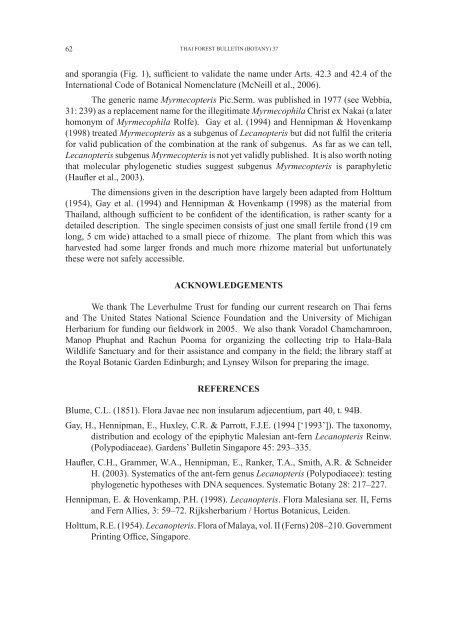You also want an ePaper? Increase the reach of your titles
YUMPU automatically turns print PDFs into web optimized ePapers that Google loves.
62<br />
<strong>THAI</strong> <strong>FOREST</strong> <strong>BULLETIN</strong> (BOTANY) 37<br />
and sporangia (Fig. 1), sufficient to validate the name under Arts. 42.3 and 42.4 of the<br />
International Code of Botanical Nomenclature (McNeill et al., 2006).<br />
The generic name Myrmecopteris Pic.Serm. was published in 1977 (see Webbia,<br />
31: 239) as a replacement name for the illegitimate Myrmecophila Christ ex Nakai (a later<br />
homonym of Myrmecophila Rolfe). Gay et al. (1994) and Hennipman & Hovenkamp<br />
(1998) treated Myrmecopteris as a subgenus of Lecanopteris but did not fulfil the criteria<br />
for valid publication of the combination at the rank of subgenus. As far as we can tell,<br />
Lecanopteris subgenus Myrmecopteris is not yet validly published. It is also worth noting<br />
that molecular phylogenetic studies suggest subgenus Myrmecopteris is paraphyletic<br />
(Haufler et al., 2003).<br />
The dimensions given in the description have largely been adapted from Holttum<br />
(1954), Gay et al. (1994) and Hennipman & Hovenkamp (1998) as the material from<br />
Thailand, although sufficient to be confident of the identification, is rather scanty for a<br />
detailed description. The single specimen consists of just one small fertile frond (19 cm<br />
long, 5 cm wide) attached to a small piece of rhizome. The plant from which this was<br />
harvested had some larger fronds and much more rhizome material but unfortunately<br />
these were not safely accessible.<br />
ACKNOWLEDGEMENTS<br />
We thank The Leverhulme Trust for funding our current research on Thai ferns<br />
and The United States National Science Foundation and the University of Michigan<br />
Herbarium for funding our fieldwork in 2005. We also thank Voradol Chamchamroon,<br />
Manop Phuphat and Rachun Pooma for organizing the collecting trip to Hala-Bala<br />
Wildlife Sanctuary and for their assistance and company in the field; the library staff at<br />
the Royal Botanic Garden Edinburgh; and Lynsey Wilson for preparing the image.<br />
REFERENCES<br />
Blume, C.L. (1851). Flora Javae nec non insularum adjecentium, part 40, t. 94B.<br />
Gay, H., Hennipman, E., Huxley, C.R. & Parrott, F.J.E. (1994 [‘1993’]). The taxonomy,<br />
distribution and ecology of the epiphytic Malesian ant-fern Lecanopteris Reinw.<br />
(Polypodiaceae). Gardens’ Bulletin Singapore 45: 293–335.<br />
Haufler, C.H., Grammer, W.A., Hennipman, E., Ranker, T.A., Smith, A.R. & Schneider<br />
H. (2003). Systematics of the ant-fern genus Lecanopteris (Polypodiacee): testing<br />
phylogenetic hypotheses with DNA sequences. Systematic Botany 28: 217–227.<br />
Hennipman, E. & Hovenkamp, P.H. (1998). Lecanopteris. Flora Malesiana ser. II, Ferns<br />
and Fern Allies, 3: 59–72. Rijksherbarium / Hortus Botanicus, Leiden.<br />
Holttum, R.E. (1954). Lecanopteris. Flora of Malaya, vol. II (Ferns) 208–210. Government<br />
Printing Office, Singapore.
















